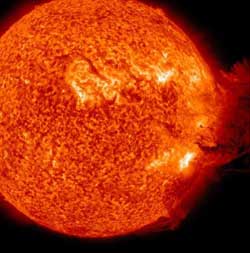NASA sees the sun having a solar blast

This is a Coronal Mass Ejection as viewed by the Solar Dynamics Observatory on June 7, 2011. Credit: Credit: NASA/SDO<br><br>
The Solar Dynamics Observatory (SDO) observed the flare's peak at 1:41a.m. ET (0641 UT). SDO recorded these images (above) in extreme ultraviolet light that show a very large eruption of cool gas. It is somewhat unique because at many places in the eruption there seems to be even cooler material — at temperatures less than 80,000 K.
When viewed in Solar and Heliospheric Observatory's (SOHO) coronagraphs (right), the event shows bright plasma and high-energy particles roaring from the Sun. This not-squarely Earth-directed CME is moving at 1400 km/s according to NASA models.
The CME should deliver a glancing blow to Earth's magnetic field during the late hours of June 8th or June 9th. High-latitude sky watchers should be alert for auroras when the CME arrives.
Check back shortly as more media is coming in as this is being published.
What is a solar flare? What is a CME?
For answers to these and other space weather questions, please visit the Spaceweather Frequently Asked Questions page: http://www.nasa.gov/mission_pages/sunearth/spaceweather/index.html
Media Contact
More Information:
http://www.nasa.govAll latest news from the category: Physics and Astronomy
This area deals with the fundamental laws and building blocks of nature and how they interact, the properties and the behavior of matter, and research into space and time and their structures.
innovations-report provides in-depth reports and articles on subjects such as astrophysics, laser technologies, nuclear, quantum, particle and solid-state physics, nanotechnologies, planetary research and findings (Mars, Venus) and developments related to the Hubble Telescope.
Newest articles

A universal framework for spatial biology
SpatialData is a freely accessible tool to unify and integrate data from different omics technologies accounting for spatial information, which can provide holistic insights into health and disease. Biological processes…

How complex biological processes arise
A $20 million grant from the U.S. National Science Foundation (NSF) will support the establishment and operation of the National Synthesis Center for Emergence in the Molecular and Cellular Sciences (NCEMS) at…

Airborne single-photon lidar system achieves high-resolution 3D imaging
Compact, low-power system opens doors for photon-efficient drone and satellite-based environmental monitoring and mapping. Researchers have developed a compact and lightweight single-photon airborne lidar system that can acquire high-resolution 3D…





















